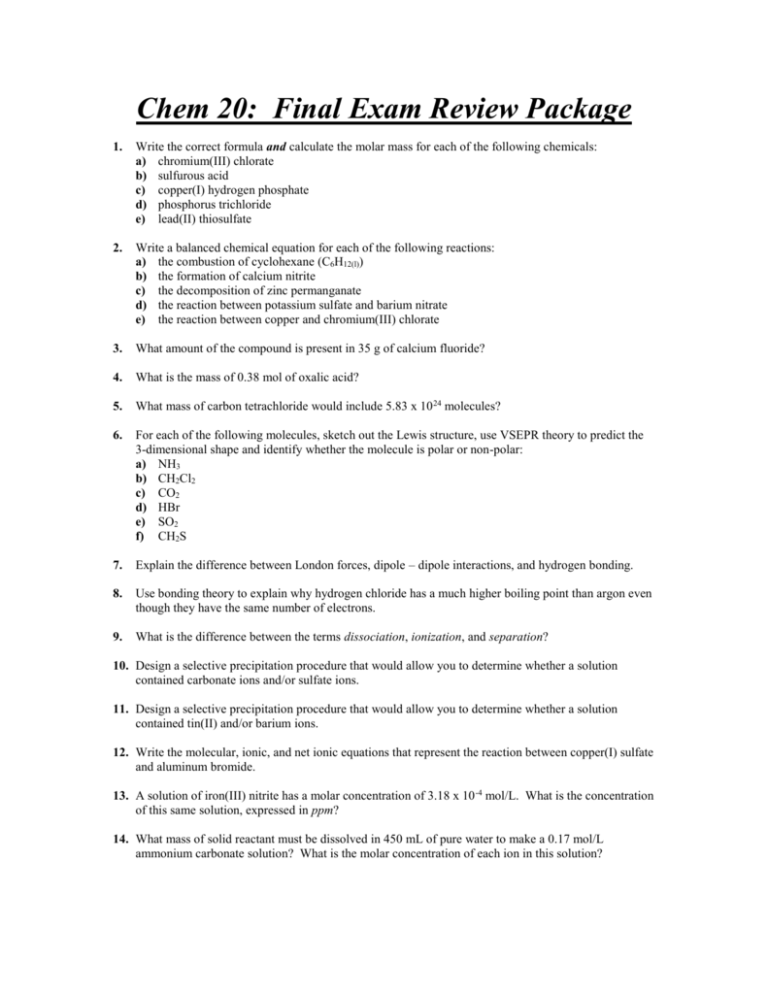Chem 20: Final Exam Review Package
advertisement

Chem 20: Final Exam Review Package 1. Write the correct formula and calculate the molar mass for each of the following chemicals: a) chromium(III) chlorate b) sulfurous acid c) copper(I) hydrogen phosphate d) phosphorus trichloride e) lead(II) thiosulfate 2. Write a balanced chemical equation for each of the following reactions: a) the combustion of cyclohexane (C6H12(l)) b) the formation of calcium nitrite c) the decomposition of zinc permanganate d) the reaction between potassium sulfate and barium nitrate e) the reaction between copper and chromium(III) chlorate 3. What amount of the compound is present in 35 g of calcium fluoride? 4. What is the mass of 0.38 mol of oxalic acid? 5. What mass of carbon tetrachloride would include 5.83 x 10 24 molecules? 6. For each of the following molecules, sketch out the Lewis structure, use VSEPR theory to predict the 3-dimensional shape and identify whether the molecule is polar or non-polar: a) NH3 b) CH2Cl2 c) CO2 d) HBr e) SO2 f) CH2S 7. Explain the difference between London forces, dipole – dipole interactions, and hydrogen bonding. 8. Use bonding theory to explain why hydrogen chloride has a much higher boiling point than argon even though they have the same number of electrons. 9. What is the difference between the terms dissociation, ionization, and separation? 10. Design a selective precipitation procedure that would allow you to determine whether a solution contained carbonate ions and/or sulfate ions. 11. Design a selective precipitation procedure that would allow you to determine whether a solution contained tin(II) and/or barium ions. 12. Write the molecular, ionic, and net ionic equations that represent the reaction between copper(I) sulfate and aluminum bromide. 13. A solution of iron(III) nitrite has a molar concentration of 3.18 x 10 -4 mol/L. What is the concentration of this same solution, expressed in ppm? 14. What mass of solid reactant must be dissolved in 450 mL of pure water to make a 0.17 mol/L ammonium carbonate solution? What is the molar concentration of each ion in this solution? 15. 250 g of copper(II) sulfate is dissolved in 14750 mL of water. What is the molar concentration of this solution? What is the molar concentration of each ion in this solution? 16. Water is added to 145 mL of 2.40 mol/L ammonia solution until the solution reaches a volume of 1.00 L. What is the new molar concentration of this ammonia solution? 17. Describe completely how you would prepare 100 mL of 1.50 mol/L sulfuric acid by dilution of a 17.8 mol/L stock solution. 18. Calculate the pH of a solution that has 150 g of hydrogen chloride gas completely dissolved in 2350 mL of water. 19. A flexible container holds 250 mL of nitrogen gas at a pressure of 1.25 atm. If the pressure is increased to 5.6 bar at a constant temperature of 37 oC, what is the new volume of the container? What mass of gas is inside the container? 20. A weather balloon has a volume of 15 L under STP conditions. The balloon is released into the atmosphere and after 15 minutes, it has a pressure of 82 kPa and a temperature of –39oC. What is the new volume of the balloon? 21. Determine the pressure in a 50 L compressed air tank if 30 mol of air is present in the container at 30oC. 22. What should happen to the molar volume of a gas if the pressure exerted on it is doubled when its absolute temperature is halved? 23. What mass of oxygen is required to completely burn 150 g of nonane (C9H20(l))? If the conditions inside the combustion chamber are 135 kPa and 250 oC, what volume of oxygen is required during this reaction? 24. Iron(III) oxide is produced in a formation reaction. What mass of each reactant is required to produced 75 g of iron(III) oxide? 25. What volume of 0.35 mol/L hydrochloric acid is required to completely react with 250 mL of 0.13 mol/L sodium hydroxide? 26. A chemist performs a titration to determine the concentration of a barium hydroxide solution. The chemist finds that it takes an average volume of 17.6 mL of a 0.20 mol/l standard solution of hydrochloric acid to reach the endpoint when it reacts with 25 mL of the barium hydroxide. What is the molar concentration of the barium hydroxide solution? What mass of solid barium hydroxide would have been required to produce 500 mL of this reacting solution? 27. A student mixes 5.00 g of zinc with 750 mL of 0.199 mol/L silver nitrate. After collecting the silver produced by the reaction, the mass of silver is measured to be 13.30 g. What is the percent yield for this experiment? Additional Textbook Review Questions: 1) p. 750-755 (Units 1-4) - Answers on p. 741 2) p. 86, p. 156, p. 248, p. 328 – Teacher has answers







